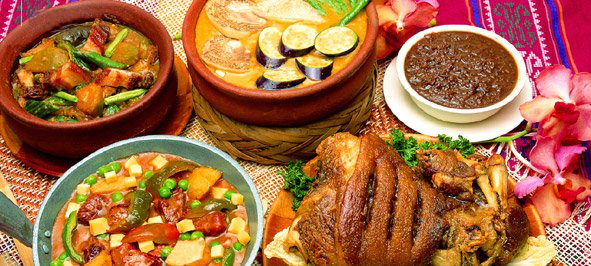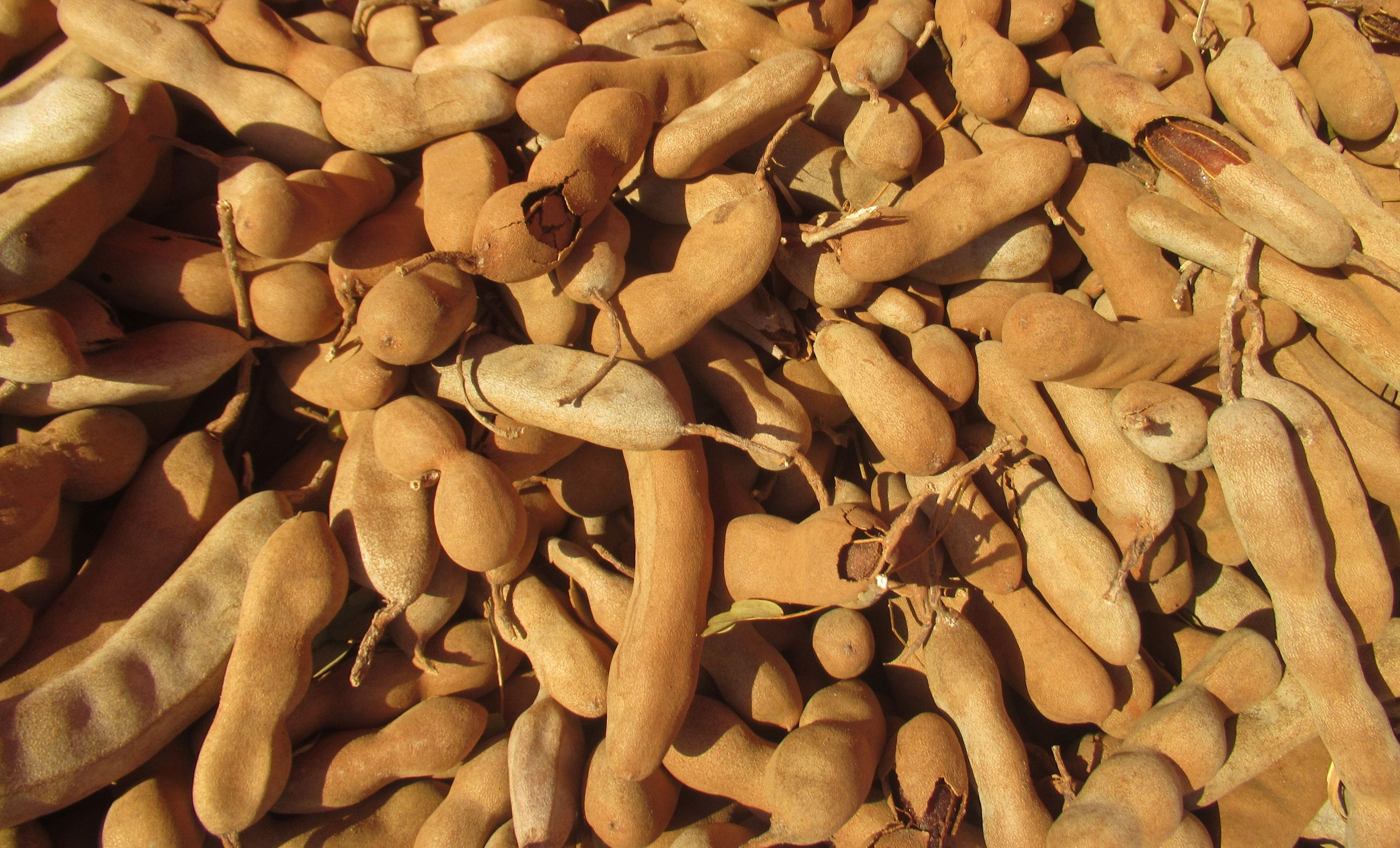|
Sinampalukang Manók
''Sinampalukan'', also known as ''sinampalukang manók'' or tamarind chicken, is a Filipino chicken soup consisting of chicken cooked in a sour broth with tamarind, tamarind leaves, ginger, onion, garlic, and other vegetables. Name The term ''sinampalukan'' literally means " ookedwith tamarind", from Tagalog ''sampalok'', "tamarind". Description ''Sinampalukan'' is prepared by first sautéing the chicken with garlic, ginger, and onions. Water is then added with tamarind pulp, young tamarind leaves and usually ''siling haba'' or ''labuyo'' chilis and tomatoes. Other vegetables can also be added if desired, including green beans, pechay, cabbage, eggplant, and others. It is served over white rice. ''Sinampalukan'' is regarded as a comfort food, usually served to sick people or during cold days. ''Sinampalukan'' is very similar to ''sinigang'' and is sometimes regarded as a mere variant of the latter. However, ''sinampalukan'' differs most obviously in that it uses tamarind leav ... [...More Info...] [...Related Items...] OR: [Wikipedia] [Google] [Baidu] |
Main Dish
A main course is the featured or primary dish in a meal consisting of several courses. It usually follows the entrée () course. Usage In the United States and Canada (except Quebec), the main course is traditionally called an "entrée". English-speaking Québécois follow the modern French use of the term entrée to refer to a dish served before the main course. According to linguist Dan Jurafsky, North American usage ("entrée") comes from the original French meaning of the first of many meat courses. See also * Full course dinner A full-course dinner in much of the Western world is a meal served in multiple courses. Since the 19th century, dinner has generally been served in the evening, but other times ranging from late morning to late afternoon have been historically ... References Bibliography * External links Wikibooks Cookbook Food and drink terminology Courses (food) {{food-stub tl:Ulam ... [...More Info...] [...Related Items...] OR: [Wikipedia] [Google] [Baidu] |
Philippine Cuisine
Filipino cuisine is composed of the cuisines of more than a hundred distinct Ethnic groups in the Philippines, ethnolinguistic groups found throughout the Philippines, Philippine archipelago. A majority of mainstream Filipino dishes that comprise Filipino cuisine are from the food traditions of various ethnolinguistic groups and tribes of the archipelago, including the Ilocano people, Ilocano, Pangasinan people, Pangasinan, Kapampangan people, Kapampangan, Tagalog people, Tagalog, Bicolano people, Bicolano, Visayan, Chavacano, and Maranao people, Maranao ethnolinguistic groups. The dishes associated with these groups evolved over the centuries from a largely indigenous (largely Austronesian peoples, Austronesian) base shared with maritime Southeast Asia with varied influences from Chinese cuisine, Chinese, Spanish cuisine, Spanish, and American cuisine, American cuisines, in line with the major waves of influence that had enriched the cultures of the archipelago, and adapted us ... [...More Info...] [...Related Items...] OR: [Wikipedia] [Google] [Baidu] |
Chicken Soup
Chicken soup is a soup made from chicken, simmered in water, usually with various other ingredients. The classic chicken soup consists of a clear chicken broth, often with pieces of chicken or vegetables; common additions are pasta, noodles, dumplings, carrots, potatoes, or grains such as rice and barley. Chicken soup is commonly considered a comfort food. History Humans were already boiling food by the time that chicken was domesticated in the Neolithic period, so it is likely that chickens were being boiled for soup. Modern American chicken soup, which typically includes root vegetables such as carrot, onion, leeks and celery, was a staple across Northern Europe and was brought to the United States by immigrants. Preparation Variations on the flavor are gained by adding root vegetables such as parsnip, potato, sweet potato and celery root; herbs such as bay leaves, parsley and dill; other vegetables such as zucchini, whole garlic cloves, lettuce, or tomatoes; and black pe ... [...More Info...] [...Related Items...] OR: [Wikipedia] [Google] [Baidu] |
Chicken As Food
Chicken is the most common type of poultry in the world. Owing to the relative ease and low cost of raising chickens—in comparison to mammals such as cattle or Pig, hogs—chicken meat (commonly called just "chicken") and chicken Chicken eggs, eggs have become prevalent in numerous cuisines. Chicken can be prepared in a vast range of ways, including baking, grilling, barbecuing, frying, boiling, and roasting. Since the latter half of the 20th century, prepared chicken has become a staple of fast food. Chicken is sometimes cited as being more healthy than red meat, with lower concentrations of cholesterol and saturated fat. The poultry farming industry that accounts for chicken production takes on a range of forms across different parts of the world. In developed country, developed countries, chickens are typically subject to intensive farming methods while less-developed areas raise chickens using more traditional farming techniques. The United Nations estimates there to be ... [...More Info...] [...Related Items...] OR: [Wikipedia] [Google] [Baidu] |
Tamarind
Tamarind (''Tamarindus indica'') is a Legume, leguminous tree bearing edible fruit that is indigenous to tropical Africa and naturalized in Asia. The genus ''Tamarindus'' is monotypic taxon, monotypic, meaning that it contains only this species. It belongs to the family Fabaceae. The tamarind tree produces brown, pod-like fruits that contain a sweet, tangy pulp, which is used in cuisines around the world. The pulp is also used in traditional medicine and as a metal polish. The tree's wood can be used for woodworking and #Seed oil and kernel powder, tamarind seed oil can be extracted from the seeds. Tamarind's tender young leaves are used in Indian cuisine, Indian and Filipino cuisine. Because tamarind has multiple uses, it is cultivated around the world in Tropical zone, tropical and Subtropics, subtropical zones. Description The tamarind is a long-living, medium-growth tree, which attains a maximum crown (botany), crown height of . The crown has an irregular, vase-shape ... [...More Info...] [...Related Items...] OR: [Wikipedia] [Google] [Baidu] |
Tagalog Language
Tagalog ( ,According to the ''OED'' anMerriam-Webster Online Dictionary ; ''Baybayin'': ) is an Austronesian language spoken as a first language by the ethnic Tagalog people, who make up a quarter of the population of the Philippines, and as a second language by the majority, mostly as or through Filipino language, Filipino. Its de facto Standard language, standardized and codified form, officially named ''Filipino'', is the national language of the Philippines, and is one of the nation's two official languages, alongside Philippine English, English. Tagalog, like the other and as one of the regional languages of the Philippines, which majority are Austronesian languages, Austronesian, is one of the auxiliary official languages of the Philippines in the regions and also one of the auxiliary media of instruction therein. Tagalog is closely related to other Philippine languages, such as the Bikol languages, the Bisayan languages, Ilocano language, Ilocano, Kapampangan language, ... [...More Info...] [...Related Items...] OR: [Wikipedia] [Google] [Baidu] |
Siling Haba
''Siling haba'' ("long chili"), ''espada'' ("sword" in Spanish), ''siling mahaba'', ''siling pangsigang'' ("chili for ''sinigang''"), ''siling Tagalog'' ("Tagalog chili"), and sometimes called green chili, finger chili or long pepper, is one of two kinds of chili common to the Philippines and Filipino cuisine, the other being '' siling labuyo''. Unlike ''siling labuyo'', it belongs to the species ''Capsicum annuum''. The ''siling haba'' fruit grows to between long, and is bright light green in color. While of moderate spiciness, it is much milder and less hot than ''siling labuyo''. It is an ingredient commonly used in Philippine cuisine, spicing up dishes like sinigang, dinuguan, pinangat, kilawin, paksiw, and sisig. See also *Bird's eye chili Bird's eye chili or Thai chili ( owing to its shape) is a chili pepper variety (botany), variety from the species ''Capsicum annuum'' that is native to Mexico. Cultivated across Southeast Asia, it is used extensively in many Asian ... [...More Info...] [...Related Items...] OR: [Wikipedia] [Google] [Baidu] |
Labuyo
''Siling labuyo'' is a small chili pepper cultivar that developed in the Philippines after the Columbian Exchange. It belongs to the species ''Capsicum frutescens'' and is characterized by triangular fruits that grow pointing upwards. The fruits and leaves are used in traditional Philippine cuisine. The fruit is pungent, ranking at 80,000 to 100,000 heat units in the Scoville Scale. The cultivar name is Tagalog, and literally translates to "wild chili." It is also known simply as ''labuyo'' or ''labuyo'' chili. Thai bird's eye chili are commonly confused with Labuyo in the Philippines, though they are cultivars of two different species, and much larger fruit. ''Siling labuyo'' is one of two common kinds of local chili found in the Philippines, the other being '' siling haba'' (a ''Capsicum annuum'' cultivar). ''Siling labuyo'' is generally accepted as the world's smallest hot pepper, as the fruit often measures a mere in length by in width. It is listed in the Ark of Taste ... [...More Info...] [...Related Items...] OR: [Wikipedia] [Google] [Baidu] |
Bokchoi
Bok choy (American English, Canadian English, and Australian English), pak choi (British English, South African English, and Caribbean English) or pok choi is a type of Chinese cabbage (''Brassica rapa'' subsp. ''chinensis'') cultivated as a leaf vegetable to be used as food. Varieties do not form heads and have green leaf blades with lighter bulbous bottoms instead, forming a cluster reminiscent of mustard greens. Its flavor is described as being between spinach and water chestnuts but slightly sweeter, with a mildly peppery undertone. The green leaves have a stronger flavor than the white bulb. ''Chinensis'' varieties are popular in southern China, East Asia, and Southeast Asia. Originally classified as ''Brassica chinensis'' by Carl Linnaeus, they are now considered a subspecies of ''Brassica rapa. ''They are a member of the family Brassicaceae. Spelling and naming variations Other than the term "Chinese cabbage", the most widely used name in North America for the ''chinensis ... [...More Info...] [...Related Items...] OR: [Wikipedia] [Google] [Baidu] |
Comfort Food
Comfort food is food that provides a nostalgic or sentimental value to someone and may be characterized by its high caloric nature associated with childhood or home cooking. The nostalgia may be specific to an individual or it may apply to a specific culture. Definition and history The term ''comfort food'' can be traced back at least to 1615, where in the beginning of the second part of Don Quixote, at the beginning of chapter one, Quixote's niece and her nurse (governess, housekeeper?, "ama") are told to pamper him, "to give him things to eat which are comforting and appropriate for the heart and the brain... ." Others trace it back to 1966, when the '' Palm Beach Post'' used it in a story: "Adults, when under severe emotional stress, turn to what could be called 'comfort food'—food associated with the security of childhood, like mother's poached egg or famous chicken soup." According to research by April White at JSTOR, it might have been Liza Minnelli who used the ter ... [...More Info...] [...Related Items...] OR: [Wikipedia] [Google] [Baidu] |
Sinigang
''Sinigang'', sometimes anglicized as sour broth, is a Filipino soup or stew characterized by its sour and savory taste. It is most often associated with tamarind (Filipino language, Filipino: ''sampalok''), although it can use other sour fruits and leaves as the souring agent such as unripe mangoes or rice vinegar. It is one of the more popular dishes in Filipino cuisine. This soup, like most Filipino dishes, is usually accompanied by rice. Origin ''Sinigang'' means "stewed [dish]"; it is Nominalization, nominalized in the form of the Tagalog language, Tagalog verb ''sigang'', "to stew". While present nationwide, ''sinigang'' is seen to be culturally Tagalog people, Tagalog in origin, thus the similar sour stews and soups found in the Visayas and Mindanao (like ''linarang'') and in the Province of Pampanga their version of a sour soup is Called "BulangLang". These are regarded as different dishes and differ in the ingredients used. Fish sauce is a common condiment for the stew. ... [...More Info...] [...Related Items...] OR: [Wikipedia] [Google] [Baidu] |
Linarang
''Linarang'', also known as ''larang'' or ''nilarang'', is a Filipino fish stew originating from the Central Visayas islands. It is made with fish in a spicy and sour coconut milk-based broth with garlic, red onions, tomatoes, fermented black beans (''tausi''), chilis, and sour fruits. Etymology The name ''linarang'' or ''nilarang'' (lit. "done as ''larang''"), is the affixed form of the Cebuano verb ''larang'', meaning "to stew with coconut milk and spices". The word is originally a synonym of the ''ginataan'' cooking process (''ginat-an'' or ''tinunoan'' in Cebuano), but has come to refer exclusively to this particular dish. Description ''Linarang'' is prepared by first sautéing the fish with garlic, red onions, and tomatoes. It is then added to a broth with fermented black beans (''tausi''), chilis, and a souring agent. The souring agent is usually bilimbi (''iba''), unripe mangoes, or tamarind (''sambag''), but can also be any sour fruit. Variations ''Linarang'' can va ... [...More Info...] [...Related Items...] OR: [Wikipedia] [Google] [Baidu] |








